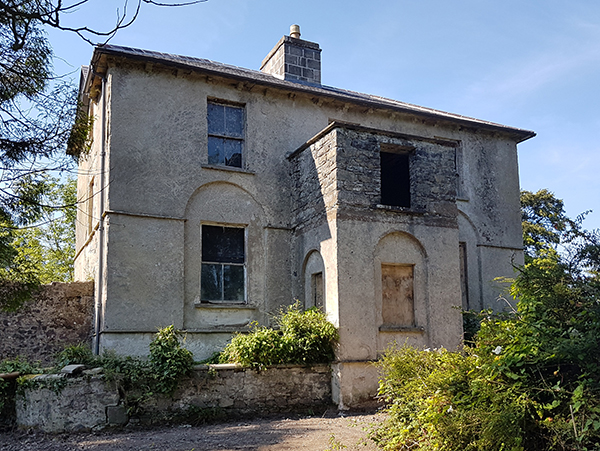Ballysakeery Glebe House
Published in Gems of Architecture, Issue 4 (July/August 2018), Volume 26Mullafarry, Co. Mayo
By David Hicks
Ballysakeery glebe house, hidden on a tree-lined road off the R314 from Ballina to Killala, was the birthplace and childhood home of Dr Kathleen Lynn (1874–1955), chief medical officer at the City Hall garrison during the 1916 Rising and co-founder in 1919 of St Ultan’s Children’s Hospital. Owing to its architectural and historical significance, the house received funding from the Department of Culture, Heritage and the Gaeltacht under the Structures at Risk Fund 2016 for emergency repair works, and additional funding under the Structures at Risk Fund 2017.

Above: Ballysakeery glebe house after the first stage of restoration in December 2016. (David Hicks)
The building dates back to the early 1800s, when a new parish church was erected in Lisglennon townland. Ballysakeery was one of many Church of Ireland churches built or rebuilt between 1808 and 1823 with help from the Board of First Fruits (fl. 1711–1833), which provided a gift of £400 and an equal loan of £400 for the construction of a glebe house in the neighbouring townland of Mullafarry.
The architect is unknown, although drawings survive. Work was authorised to commence on 1 August 1815. At first glance the house is typical of many glebe houses built at the time: a streamlined Classical façade with a canopied central door-case; window openings in arcaded recesses on the ground floor; slightly smaller window openings above; and simple stonework embellishing the eaves. The symmetry of the façade is misleading, however, and there is an interesting segregation of the interior, where three floors of low-ceilinged rooms for the staff to the left of the hall correspond to two floors of high-ceilinged rooms for the family to the right. A 1925 description lists a hall, dining room, drawing room and three bedrooms, together with a kitchen and stores in the basement.
The glebe house was home to the incumbent until 1933, when Ballysakeery church closed and the house passed into private ownership. It eventually formed part of a land bank purchased for the development of the Asahi Synthetic Fibre Plant (1977) and fell into disrepair. The first hope for a brighter future came when it passed to Mayo County Council, but the structure was in a perilous state: a roof on the point of collapse, walls showing long-term water penetration, structurally unsound chimney-breasts, subsiding floors and broken or missing windows. The dilapidated interior retained features of interest, including door and window architraves and simple moulded plasterwork cornices.
A tender for stabilisation works was advertised in June 2016. The first restoration stage saw the roof stripped back to its timber skeleton, with the original slate and ridge tiles stacked for reuse. The limestone of the central chimney-stack was numbered and dismantled to allow faithful reconstruction; among the interesting features uncovered were the marks stamped into the heads of the nails (‘VIII’), the chimney-pots (‘GARNKIRK’) and the ridge tiles (‘R. ASHTON & Co. BUCKLEY FLINTSHIRE’).
The chimney-stack was reconstructed and repointed with lime mortar. Many original slates were reused; damaged slates were recut for use on the angles of ridges and valleys. The glebe house can now again boast a watertight roof. New rainwater goods brought the first stage of the restoration to a satisfactory end. Plywood sheets on the doors and windows, perforated for ventilation, allow the house to dry out gradually before the next stage.
David Hicks works with Bourke Builders of Ballina, who specialise in the conservation of historic buildings. Series based on the NIAH’s ‘building of the month’, www.buildingsofireland.com.
















